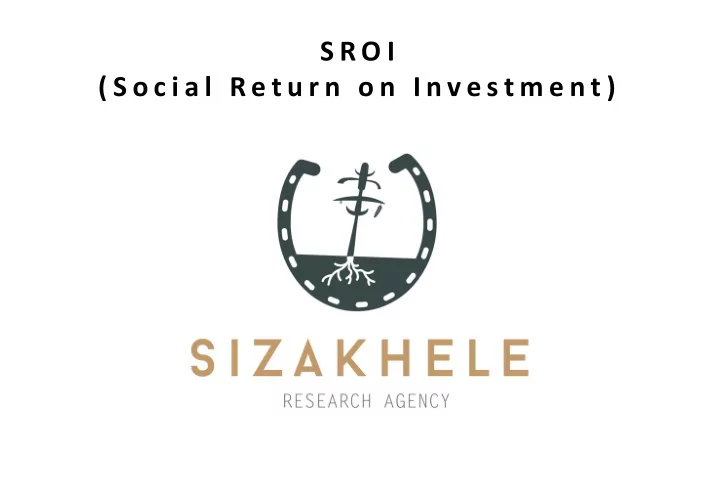

S R O I ( S o c i a l R e t u r n o n I n v e s t m e n t )
Origins of SROI SROI originates in the 1990 ’s from the Robert’s Enterprise Development Fund when a cost-benefit analysis model was extended to include social benefits through monetising social outcomes. It is a people centric model which focuses on the most important sources of value as defined and experienced by stakeholders. To achieve this SROI measures the value of benefits across a triple bottom line of social, environmental and economic outcomes . There are two types of SROI • Evaluative: Retrospective and based on existing outcomes. • Forecasting: Predicts how much social value will be created if outcomes are achieved Giving you an unfair r advantage antage
SROI Principles & Stages Principles Stages Establish Scope & Identify Stakeholders Mapping Outcomes Evidencing Outcomes & Giving them a Value Establishing Impact Calculating the SROI Reporting, Using & Embedding Giving you an unfair r advantage antage
Evidencing Outcomes & Giving Them a Value 1. Develop Indicators - Both Subjective and Objective - Value What Matters (to stakeholders) 2. Collect Outcomes Data 3. Establish how long outcomes last 4. Put a value on the outcome - Value the outcome not the indicator - Use financial proxies to estimate the social value of non-traded goods to different stakeholders. - Use research to establish financial proxy changes which occur directly and indirectly. 5. Methods for Challenging Proxies - Stated Preference and Contingent Value : How much would you pay to have or avoid a hypothetical thing. - Revealed Preference / Hedonic Pricing : How much one pays for related market goods to achieve the same outcome / build up a value from market value of constituent parts. - Travel Cost / Time Value method: Cost of travel or time loss. Giving you an unfair r advantage antage
Establishing Impact Deadweight & Displacement Deadweight accounts for how much of the outcome would have been achieved had the intervention not taken place. (e.g. national economic change v intervention change) Displacement accounts for changes that are shifted elsewhere or would have occurred regardless but for other non-stakeholders. (e.g. crime moves elsewhere or job gained would have gone to someone else in a similar situation.) Attribution How much of the outcome occurred due to other organisations or people. (e.g. Other active interventions with the same outcome) Drop-off Applies to outcomes that last longer than 1 year and focuses on decreased effectiveness or achievement of the outcome over time. (e.g. Technology implemented may become obsolete or less relevant over time.) Apply each of these negative percentages to the total value of your outcome to Calculate Impact! Giving you an unfair r advantage antage
Calculate the SROI Projecting into the Future / Applying Drop-off The calculated drop-off rate is applied to the total impact value for one year for all the years of duration of the outcome. (e.g. Yr 1 Outcome Value = R1000, drop off = 10% means Yr 2 Outcome Value = R900.) Calculating the net present value / Discounting Discounting acknowledges peoples preference for instant gratification over long-term gains due to the risk that long-term gains may never materialise or greater gains are available elsewhere. i.e. Time-value of money. (e.g. accepting R20 in a years time over R10 now is a discount rate of 100%) Generally accepted rate between 3% and 3.5%. Net Present Value = [Present Value of Benefits] – [Value of Investments] Calculate Ratio SROI Ratio = Present Value Net SROI Ratio = Net Present Value Value of Inputs Value of Inputs Giving you an unfair r advantage antage
Merits & Pitfalls Merits Pitfalls • • Triple bottom line. (Social, Not scientific, Environmental & Economic), • Relies heavily on assumptions and • Values what is important to subjective value Stakeholders, • Values what is important to • Translates intangible value into stakeholders, terms people/investors understand, • No two (2) consultants reach the • Easier to compare similar and same conclusion substantially different interventions. • Accounts for a broader understanding of stakeholders and value Giving you an unfair r advantage antage
Your Thoughts?!! Giving you an unfair r advantage antage
Tools & Resources Articles: Joyce Yee https://www.researchgate.net/figure/Examp le-of-an-SROI-Impact-Map-Nicholls-et-al- 2009-pg-102-105_fig3_265570970 SROI Guide https://issuu.com/kameliashamsuddin/docs /a_guide_to_sroi__sroiworkshopforaun Giving you an unfair r advantage antage
T H A N K YO U ! ! !
Contact Us Registered Name: Sizakhele Research Services (Pty) Ltd. Address: 60 Oakmont Jackal Creek Roodeport 2169 Contact Person: Sive Nodada E-mail: sive.nodada@sizakhele.com Cell: +27 82 562 678 Website: www.sizakhele.com Giving you an unfair r advantage antage
Recommend
More recommend